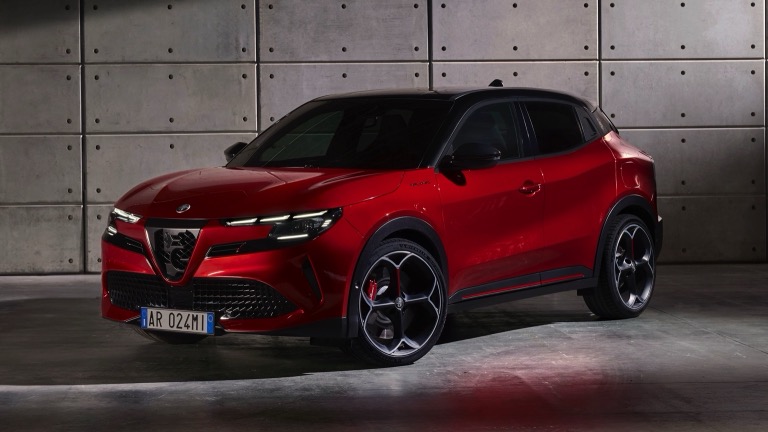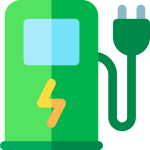
Alfa Romeo’s Australian electric push begins with the Junior – a small SUV offered in both a fully electric Elettrica and a mild-hybrid Ibrida form – and is scheduled to arrive here from late 2025.
The Junior marks Alfa Romeo’s first dedicated EV for Australia and is built on Stellantis’ e-CMP2 architecture, a platform it shares with models such as the Jeep Avenger and other group siblings. The Junior is the opening act in a broader plan to electrify Alfa Romeo’s range, with electric iterations of the Tonale and Stelvio – and eventually a flagship electric sports sedan to succeed the Giulia – expected to follow in coming years.
What the Junior Elettrica offers
- Platform and mechanicals: The Junior Elettrica rides on Stellantis’ e-CMP2 platform, a small-car EV architecture designed to balance cost, packaging and urban-oriented range.
- Battery and range: Alfa Romeo has specified a 54 kWh battery pack for the Junior Elettrica and cites up to 410 km on the WLTP cycle. As with many WLTP figures, real-world range will vary with temperature, driving style and load, but the quoted figure positions the Junior as a credible daily-driver for urban and suburban Australian usage.
- Charging: The Junior supports DC fast charging up to 100 kW. In practice this means reasonably quick top-ups – for example, an approximate 20-80 per cent charge could take in the order of 20-30 minutes under ideal conditions on a compatible charger.
- Interior and technology: Alfa Romeo aims to give the Junior a modern cabin, with dual 10.25-inch screens (instrument cluster and central infotainment), wireless Apple CarPlay and Android Auto, and a six‑speaker audio system as standard. Expect a contemporary, if compact, layout tuned to appeal to younger buyers and those seeking Italian styling cues.
- Safety and driver assistance: Standard equipment includes autonomous emergency braking (AEB), adaptive cruise control and blind‑spot monitoring. Independent crash-test ratings for the Junior in Australia (ANCAP) or Europe (Euro NCAP) may not be available at launch; purchasers should check for published results closer to release.
How the Junior fits the Australian market
The Junior arrives into an increasingly crowded and price-sensitive small-SUV EV space. In Australia, buyers are used to evaluating range, on-road running costs, and access to charging. The Junior’s 54 kWh battery and 100 kW charging capability position it as a competitor to compact EVs that prioritise city efficiency and affordability rather than long-range touring.
Practical considerations for Australian buyers:
- Real-world range: Expect WLTP figures to be optimistic in many driving conditions; cold weather, rapid highway driving and rooftop cargo all reduce range.
- Charging access: Public fast-charging networks have expanded rapidly in Australia – Chargefox, EVie, and other networks (plus Tesla Superchargers where enabled) form a practical backbone for regional travel. However, charging speeds, connector types and payment systems still vary state‑by‑state.
- Running costs and servicing: Alfa Romeo will rely on Stellantis’ dealer network in Australia for sales and aftersales support. Buyers should compare servicing plans and warranty terms against rivals, particularly as electric powertrains typically lower running maintenance but can change long‑term ownership costs.
- Incentives and taxes: There is no single national EV subsidy in Australia; state and territory programs differ and some offer concessions. Also consider threshold effects such as Luxury Car Tax when final Australian pricing is announced. Prospective buyers should check their state government’s current incentives and stamp‑duty treatments.
What’s coming after the Junior
Alfa Romeo has signalled a roadmap toward an increasingly electrified lineup. Key items to watch:
- Tonale and Stelvio replacements: Alfa Romeo intends to follow the Junior with electrified successors to the Tonale and Stelvio, bringing the brand’s core SUV range into the EV era.
- Sports sedan successor: The Giulia has long been a brand icon. Alfa Romeo has confirmed that a sports‑car ethos will remain central to the marque and that future electric performance sedans are part of the plan.
- Platform strategy: While the e-CMP2 platform suits sub‑compact applications, Stellantis also deploys larger EV architectures (like STLA Medium and Large) for higher performance and longer-range models – these architectures are likely to underpin larger Alfa Romeo EVs in future.
Market and brand implications
For Alfa Romeo, the Junior is as much about brand continuity as market share. The Italian marque is balancing its heritage – sportiness, design and driver engagement – with the realities of electrification and Stellantis’ platform-sharing strategy. The Junior’s arrival shows Alfa Romeo aiming to compete in an entry-level premium EV bracket: offering Italian design and badge appeal while leveraging cost efficiencies from shared Stellantis hardware.
Australian buyers should consider:
- Positioning: If Alfa Romeo prices the Junior competitively, it could attract buyers seeking a premium-badged small EV with distinctive styling.
- Alternatives: The market offers affordable EVs from legacy and new brands; buyers evaluating the Junior should compare features, range and dealer support against rivals like Hyundai, Kia, BYD, MG and other Stellantis‑sourced models (e.g. Jeep Avenger).
- Resale and long-term support: Watch for warranty periods on battery and driveline, and the availability of software updates and parts through the local dealer network.
Conclusion
Alfa Romeo’s Junior Elettrica marks a significant step in the brand’s transition to electrification within Australia. As an accessible, small‑SUV EV built on a proven Stellantis platform, it promises to deliver premium styling and modern tech at a compact scale. The declared 54 kWh battery and 100 kW DC charging capability make it suitable for everyday Australian driving, particularly in urban and suburban settings. However, real-world range, local pricing, and the strength of dealer aftersales support will be decisive for buyers. Looking ahead, the Junior is an opening gambit: Alfa Romeo’s broader electrification roadmap – including EV renditions of the Tonale and Stelvio and a future electric sports sedan – will determine how the marque redefines its identity in Australia’s fast-evolving EV market.
Frequently asked questions
When will the Alfa Romeo Junior Elettrica be available in Australia?
Alfa Romeo has indicated the Junior will arrive in Australia from late 2025. Exact launch dates, local specifications and on‑road pricing will be confirmed closer to release.
What real-world range can I expect from a 54 kWh battery?
WLTP quotes suggest up to around 410 km, but real-world driving range will typically be lower. Factors such as driving speed, ambient temperature, use of climate control and load affect consumption – expect reductions of 10-30 per cent in many cases.
How long does it take to charge the Junior at public fast chargers?
With up to 100 kW DC fast-charging capability, the Junior should be able to charge from roughly 20 to 80 per cent in approximately 20-30 minutes under optimal conditions. Charging times vary by charger power, battery state, and ambient conditions.
Will Alfa Romeo offer servicing and warranties for the Junior in Australia?
Alfa Romeo will use Stellantis’ dealer network for sales and aftersales in Australia. Warranty terms, including battery warranties, will be detailed at launch – compare these carefully against competitors when considering purchase.
How does the Junior compare to the Jeep Avenger?
The Junior shares platform components with the Jeep Avenger (both are e-CMP2 based), but Alfa Romeo will emphasise different styling, tuning and feature sets to preserve brand identity. Buyers should compare specifications, feature lists and pricing for the two models when they are available locally.
About EV Evolution
EV Evolution is the leading online platform dedicated to Australian electric vehicle owners and enthusiasts. We foster a vibrant community, delivering essential EV news and insights, and enhancing user engagement through our innovative, AI-powered chatbot for dynamic discussions. Our mission is to empower Australian electric vehicle owners and enthusiasts by fostering a vibrant, AI-driven online community that connects, informs, and advances the nation’s electric vehicle landscape.




